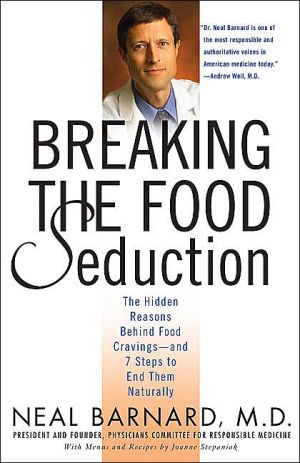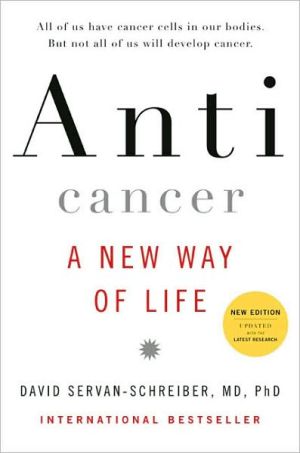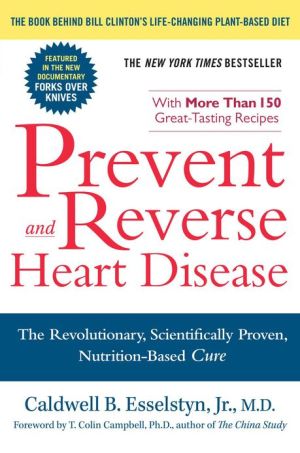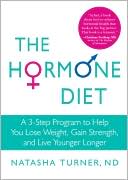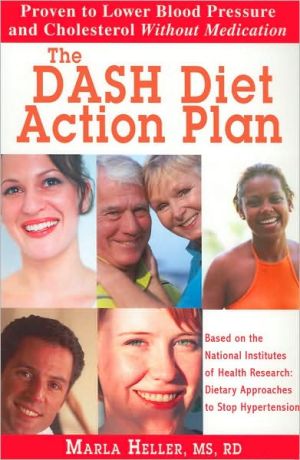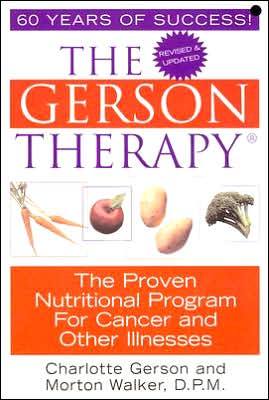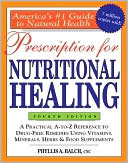Breaking the Food Seduction
Cure Your Food Cravings Once and For All\ If sweets and high-fat foods are sabotaging your efforts to lose weight and get healthy, Dr. Neal Barnard has the solution to conquering your food addictions. Backed up by scientific research, Breaking the Food Seduction explains that your biochemistry, not your lack of willpower, is the problem. Dr. Barnard reveals the simple dietary and lifestyle changes that can break the stubborn cycle of cravings and make you free to choose healthy and tasty...
Search in google:
A renowned health expert reveals the hidden reasons we crave chocolate, cookies, cheese, and other problem foods—and how we can beat the cravings once and for all If you’ve ever tried a new diet only to find yourself falling prey to the same old problem foods, read this groundbreaking book for important new solutions that really work.Breaking the Food Seduction delivers renowned expert Neal Barnard’s important research findings that explain what happens in our brain and body chemistry when we crave chocolate, cheese, and other problem foods—and how to stop these chemical cravings forever.Praise for the Work of Neal Barnard, M.D.“Dr. Neal Barnard is a brilliant visionary, one of the leading pioneers in educating the public about the healing power of diet and nutrition.” —Dean Ornish, M.D., author of Eat More, Weigh Less"Here at last is the book that shows why certain foods can be so addictive and exactly what to do about it. Its medically sound guidelines, sample menus, and wonderful recipes will help you defeat your food addictions and improve your health-and let you regain control of your life." —John J. Pippin, M.D., F.A.C.C., director of cardiovascular medicine at the Cooper Clinic"This incredibly practical book shows simple and proven ways out of troublesome dietary habits. But it also reveals how foods get us hooked—surprising facts most readers would have never suspected. It is must reading for anyone who eats--and wants to enjoy good health. Readable and reliable, practical and providing hope for millions.” —Hans A. Diehl, Dr.HSc., director of the Coronary Health Improvement Project and chairman of the board of the Lifestyle Medicine Institute“Breaking the Food Seduction is based on solid research and presented by an accomplished physician and investigator. This book squarely addresses some of the most critical nutritional problems we face—not only what we should be eating, but also how we can free ourselves from the habits that have kept too many of us from enjoying better health. With tasty and tempting meal plans and recipes, this book will have a major impact on our health.” —Henry J. Heimlich, M.D., The Heimlich Institute at Deaconess Hospital“If we all were more careful in our choices of food and drink, our health would improve enormously. Dr. Barnard has been advocating healthful nutrition for many years. His message is beginning to be heard.” —William C. Roberts, editor-in-chief of American Journal of Cardiology and director of the Baylor Cardiovascular Institute
Breaking the Food Seduction\ The Hidden Reasons Behind Food Cravings---And 7 Steps to End Them Naturally \ \ By Neal D. Barnard \ Griffin\ Copyright ©2004 Neal D. Barnard\ All right reserved.\ ISBN: 0312314949 \ \ \ Chapter One\ The Seduction Begins: How Foods Addict You \ You're not going to make me give up chocolate, are you?" the young woman asked. She had come to my office to join a research study that demanded some fairly major diet changes. But there was a limit. Chocolate was not negotiable.\ "No, we're not," I replied, to her visible relief. "But, very soon you might look at chocolate a bit differently."\ She was thirty-five, with a successful career. She was about to begin a series of diet readjustments that would help her lose weight, boost her energy, and make her healthier overall. Unbeknownst to her at the outset, however, these same diet changes were about to knock out food cravings that had been troubling her for longer than she could remember. And that would change her life.\ The truth was, even though she loved candy bars, fudge, and chocolate chip cookies, they were not entirely her friends. Each candy wrapper's nutrition label read almost like a confession-ten, twelve, or fifteen grams of fat in a single serving, and every last gram seemed to descend straight to her thighs. She liked chocolate, but she had been desperate to find some way to control it so that shecould have it when she wanted, but not be its slave.\ Does her situation sound familiar? We all get into food ruts of one kind or another, whether they involve simple daily habits or intense, recurring cravings. At the Physicians Committee for Responsible Medicine, we see their effects all too clearly in our research studies. Of all the things that influence our volunteers' weight, health, or how they feel from day to day, the number-one factor is the foods they've become hooked on.\ New discoveries have helped us understand why it is that some foods become almost magnetic. It is now abundantly clear that your desire for certain foods-chocolate, potato chips, or cookies, for example-is not simply a choice, like what color socks you'll wear or what movie you might go see. The demand is physical.\ To return to the case of our research volunteer, whose name, by the way, is Cynthia, she felt an intense craving for something sweet every evening, usually around eight or nine o'clock. It was not that she might appreciate a sweet in the way one might like a flower or a pretty picture. This was an overwhelming physical need. And it was specific. Plain table sugar didn't do it. Neither did fruit, raisins, or syrup, sweet as they may be. What she needed was a combination of sweetness and fat, with a bit of chocolate taste as an essential ingredient: a cookie, a chocolate bar, or maybe some ice cream. She might resist it for an hour or two. But sooner or later she would find herself plugging quarters into a candy machine or hurrying off to the convenience store with the same mixture of humiliation and compulsion that people feel as they fall off the wagon into the waiting arms of cigarettes, alcohol, or other addictions.\ Over the years she had gained quite a bit of weight. She had dieted, exercised, taken various weight-loss supplements, and even managed to get her meal plan in pretty good shape for short periods at a time. But nothing lasted. Unhealthy foods called her back. Like an old love song, chocolate appealed to her to return to its loving embrace.\ Her husband had no interest in sweets. But he fancied himself a pretty good cook, and loved to lay out a big breakfast of omelets made with cheese and bacon, which his father had taught him to make as a child growing up in Chicago. At lunch and dinner he generally avoided red meat, but ate a considerable amount of turkey and salmon, and he had acquired a particular taste for cheese. It did not have to be anything fancy. Cheddar had worked its way into many of his recipes, and he munched on gouda or edam with crackers in the evening while watching TV. He didn't turn up his nose at Velveeta, either, which he thought made a darn good quesadilla.\ He had a weight problem of his own, and a serious cholesterol problem, too. His doctor had put him on cholesterol-lowering drugs, which helped-but not as much as either of them had hoped. The doctor also referred him to a dietitian who went over his current diet in elaborate detail and then pronounced his sentence: no more than six ounces of meat per day. One egg yolk per week. Cottage cheese. At that point he went blank, while she went on about having at least five servings of fruits and vegetables every day, drinking plenty of water, and blah, blah, blah, blah. If this was living, he would rather die.\ In a very real sense, both were addicts, although neither would have used such a strong word. The fact is, they had both become hooked on specific foods that were tremendously compelling and even habituating. And the reason, it appears, is that these foods produce an overly strong reaction in the brain's pleasure center, causing the brain to keep them on its radar screen, so to speak.\ Chocolate, Cheese, and Your Brain\ The brain's pleasure center is not there just for fun. It is essential for survival. It guides you to eat, rather than waste away, and to reproduce, rather than let your genetic lineage die out. Imagine what would happen if your brain were unable to recognize pleasure, so that, for example, you got no good feeling at all from eating a meal when you were hungry. You would not look after your basic needs. Your brain's pleasure center makes you want to eat, exercise, interact with others, and even reproduce.\ Whenever an experience provides more pleasure than expected, your brain releases a bit of dopamine, the brain's main pleasure-producing chemical. If its name implies that it can make you a bit dopey, that is not far from the truth. Dopamine is central to virtually anything that feels good. An unexpected food treat, a romantic flirtation-or anything your brain takes to be a good thing-causes dopamine to lock onto brain cells and build a permanent memory trace of where pleasure comes from. It keeps flavors, scents, and even sexual experiences alive in your mind, and makes you want to experience them again and again.\ So the brain's pleasure center is just doing its job when it guides you to what it thinks you need for survival-an unexpectedly filling food or a receptive mate, for example. In the distant past, food choices were limited, and our pleasure center did not have a particularly challenging job. It helped us remember the difference between luscious, sweet fruits and immature ones, and between plump, fatty nuts and others that had become shriveled and dried. But sugary, fatty, delectable foods are everywhere nowadays, ready to confuse our senses and lead us astray.\ What if someone invented a chemical that could trigger the brain's pleasure circuitry-a chemical that did not make you stronger, help you reproduce, or assist you in any other way-but still gave your brain a feeling so warm and pleasant that you would want to repeat it over and over? Well, someone did. Heroin, cocaine, alcohol, nicotine, and, in fact, all recreational drugs work on the brain's pleasure center, triggering a greatly exaggerated dopamine response.\ Someone also invented chocolate bars, wedges of cheese, cookies, and doughnuts. All of these foods are capable of stimulating precisely the same part of the brain that responds to heroin. And that is why they can be addicting. The fact is, we've been a bit too clever for our own good, refining food products to the point where they provide all the pleasure and very little of the nutrition we need.\ Now, being addicted to a food doesn't mean you are going to end up in rehab. What it really means-for foods, drugs, or anything else-is that you have developed an intense motivation to keep taking it. This strongly compulsive quality, which is the basis of an addiction, is different from physical dependency or from having withdrawal symptoms when you quit. For example, a person who is addicted to gambling feels an intense motivation to take dangerous risks, but there are no withdrawal symptoms when the casinos are closed. Yes, many addictive substances have both a compulsive quality as well as withdrawal symptoms when you stop using them-the irritability that smokers feel, the tremors alcoholics experience, or the abdominal cramps heroin addicts have when they go cold turkey. But these symptoms relate to brain centers other than those that control addiction. They may not occur at all. Here's the point: You can be addicted to sugar, chocolate, or cheese slices, even if you don't wake up tremulous and sweating if you've missed your dose.\ Addicted to chocolate? Sounds like an overstatement, doesn't it? But the attraction to chocolate is not simply due to its taste and creamy texture. Chocolate hits the brain and causes a habituation that is as real and physical as addiction to narcotics-albeit not so destructive. As we saw in the Introduction, when volunteers take the opiate blocker naloxone, their desire for chocolate falls away almost instantly. Ditto for ice cream and other snack foods. Chocolate stimulates opiate receptors in the brain, and blocking those receptors undoes chocolate's principal attraction.\ Now, in theory, any food that tastes good can trigger the brain's pleasure center at least a little bit, and that applies to strawberries and asparagus-for people who like them-just as it does to cookies or chocolate. It is a question of degree. Some foods, like chocolate, work on the brain's pleasure center much more strongly than others, and alcohol and drugs are off the scale. The effects also differ from one person to another. Some people don't care for alcohol, while others cannot function without it. The same is true of many different foods. Cheese is irresistible to some people, but holds little interest for others.\ Many of our research volunteers are beyond passionate about chocolate. One said that a day did not go by without thoughts of the creamy, warm substance melting over her tongue. She knew full well that a Hershey Bar or two packed enough fat to show up on the scale in short order. But for her chocolate was oxygen. During our research study, she set it aside, using diet adjustments you'll see in this book. But, for weeks she continued to carry a chocolate bar with her in her purse, just to know it was there.\ It should be said that your body does not always rely on its reward system to guide your choices. When you are thirsty, you crave water. But water does not have to be stunningly delicious to be satisfying. Similarly, oxygen in the air we breathe is not especially exciting, unless you haven't had any for a minute or two. Your body has many ways to regulate how you satisfy your needs. The reward system is just one mechanism for doing that, and, as it happens, one that can easily be fooled.\ Thrill-Seekers: When Your Brain Makes Less Dopamine Than Other People's\ As we have seen, opiate-blocking medications can stop chocolate addiction dead in its tracks. These drugs have also been used to help people control other excesses of the brain's reward system. Researchers at the University of Minnesota gave an opiate blocker to a group of compulsive gamblers. Seventy-five percent of them were much improved, compared to only twenty-four percent taking a placebo. The drug's only side effect was nausea-and even that was probably less than the sick feeling they may have had seeing their money drained away.\ Researchers believe that compulsive gamblers have lower-than-normal levels of the brain's dopamine receptors, meaning that they get less pleasure from everyday activities than other people do and seek out extra stimulation just to feel normal.\ They are not the only ones. Special brain scans, called positron emission tomography, have shown that many overweight people have fewer brain receptors for dopamine, called DRD2 (dopamine receptor [D.sub.2]), compared to other people. For them, the brain-rewarding chemical has fewer places to attach to brain cells and work its magic. Presumably, they are less able to experience rewarding pleasurable feelings, and will tend to overeat to try to get the stimulation they lack. Another possibility, not yet ruled out, is that these people were not born that way, but that through repeated overeating they have somehow aused the brain to reduce the number of these dopamine attachment sites.\ Increasing scientific evidence suggests, however, that many people are, in fact, born that way. With a genetic trait handed down from their parents, their brains have 30 to 40 percent fewer of the brain receptors that are responsible for pleasurable feelings, compared to other people. They are on a constant quest to reach the normal, satisfied state other people take for granted. The low-[D.sub.2] gene has been amply demonstrated among alcoholics, especially those with serious dependency beginning early in life. It has also been found in people who abuse recreational drugs. And among smokers, those who never manage to quit are more likely to have the low-[D.sub.2] gene, compared to those who succeed at quitting, who, in turn, have a higher prevalence of the low-[D.sub.2] gene compared to people who were never attracted to tobacco in the first place.\ Among obese individuals, especially carbohydrate cravers, [D.sub.2] deficiencies are as common as they are in alcoholics, drug abusers, and smokers-suggesting that, for some, food really acts as a drug. Researchers have found that other genes also influence the brain's response to drugs, alcohol, and other substances, including food.\ These observations helped explain why alcoholism, drug abuse, and food compulsions often run in families. What is missing in these individuals is not a part of the brain that copes with alcohol or any specific drug. What is deficient is the brain receptor for normal feelings of pleasure. As a result, they are vulnerable to anything that provides it: One family member might be hooked on wine, another on drugs, and another on compulsive overeating, and they may have more than one addiction at the same time.\ You may be asking whether you or your loved ones carry this genetic trait. Unfortunately, it is not something doctors routinely check. However, you can get a pretty good idea if the low-[D.sub.2] gene, or other addiction-fostering genes, may lurk on your chromosomes from a simple glance at your family tree. Think about your parents, grandparents, and siblings. What are/were their drinking and eating habits like? What they drink is not so important as how much and how often, and how young they were when trouble started. A person who drinks only occasionally, or who smoked but managed to quit, is less likely to be responding to a genetic trait than someone who persists in these habits even when things get out of hand.\ Whatever your family history, one thing is clear: genes are not destiny.\ \ \ \ Continues... \ \ \ Excerpted from Breaking the Food Seduction by Neal D. Barnard Copyright ©2004 by Neal D. Barnard. Excerpted by permission.\ All rights reserved. No part of this excerpt may be reproduced or reprinted without permission in writing from the publisher.\ Excerpts are provided by Dial-A-Book Inc. solely for the personal use of visitors to this web site. \ \
\ From the Publisher\ "Dr. Neal Barnard is one of the most responsible and authoritative voices in American medicine today."\ - Andrew Weil, M.D.\ "Dr. Neal Barnard is a brilliant visionary, one of the leading pioneers in educating the public about the healing power of diet and nutrition."\ - Dean Ornish, M.D., author of Eat More, Weigh Less\ "Here at last is the book that shows why certain foods can be so addictive and exactly what to do about it."\ - John J. Pippin, M.D., F.A.C.C., Director of Cardiovascular Medicine at The Cooper Clinic\ "...must reading for anyone who eats - and wants to enjoy good health."\ - Has A. Diehl, Dr.HSc., Director of the Coronary Health Improvement Project and Chairman of the Board of The Lifestyle Medicine Institure\ "This book squarely addresses some of the most critical nutritional problems we face - not only what we should be eating, but also how we can free ourselves from the habits that have kept too many of us from enjoying better health."\ - Henry Heimlich, M.D., The Heimlich Institute at Deaconess Hospital\ \ \ \
